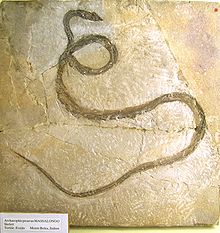

45°35′43″N 11°12′36″E / 45.59528°N 11.21000°E / 45.59528; 11.21000
| Monte Bolca | |
|---|---|
| Stratigraphic range: Late Ypresian, 50–49 Ma
↓ | |
| Type | Lagerstätte |
| Sub-units | Pesciacara, Monte Postale, Purga di Bolca, Vegroni |
| Lithology | |
| Primary | Limestone, marl, lignite |
| Other | Volcaniclastic |
| Location | |
| Coordinates | 45°36′N 11°12′E / 45.6°N 11.2°E / 45.6; 11.2 |
| Approximate paleocoordinates | 37°18′N 10°18′E / 37.3°N 10.3°E / 37.3; 10.3 |
| Region | Veneto |
| Country | |
| Type section | |
| Named for | Bolca, Italy |
| Named by | Giovanni Serafino Volta |
| Year defined | 1789 |
Monte Bolca is a lagerstätte near Verona, Italy that was one of the first fossil sites with high quality preservation known to Europeans, and is still an important source of fossils from the Eocene.[1]
Monte Bolca was uplifted from the Tethys Ocean floor during the formation of the Alps, in two stages: one 24 million years ago, and one between 30 and 50 million years ago. The entire formation consists of 19 metres (62 ft) of limestone, all of which contain fossils, but interspersed in which are the lagerstätte layers that contain the highly preserved specimens.
Within these layers, the fish and other specimens are so highly preserved that their organs are often completely intact in fossil form, and even the skin color[2] can sometimes be determined.[3] The normal rearrangement of the specimens caused by mud-dwelling organisms in the layer before it turned to stone has been avoided—it is assumed that the mud in question was low in oxygen, preventing both decay and the mixing action of scavengers.[2]

Strictly speaking, the Monte Bolca site is one specific spot near the village of Bolca in Italy, known as the Pesciara ("The Fishbowl") due to its many extraordinarily well preserved Eocene fish fossils.[4] However, there are several other related outcroppings in the general vicinity that also carry similar fossils, such as Monte Postale and Monte Vegroni.[5] The term Monte Bolca is used interchangeably to refer to the one, original site, or to all the sites collectively.
The fossils at Monte Bolca have been known since at least the 16th century,[6] though the first extensive research was conducted on them by Giovanni Serafino Volta in the late 18th century.[1] They were studied intensively in the 19th century once it was definitively proven that fossils were the remnants of dead animals.
Fossils from Monte Bolca are commonly available for sale by commercial fossil dealers, and due to their popularity and preservation regularly sell for several hundred dollars.
Monte Bolca is rich in fish: 250 species (140 genera, 90 families and 19 orders).[7] Additionally a cephalopod, crustaceans, jellyfish and polychaete worms have been found whole, but foraminifera, molluscs, and corals are found in fragments and may have been transported.[7] Bird feathers and tortoise shell plates have been found, as well as many insects, freshwater and land plants.[7]
Fossil animal species include
One of the more interesting puzzles in ichnotaxonomy, pertains to fossils from Monte Bolca, originally named Zoophycos caput-medusae, previously thought to be trace fossils, were found to be plants instead and given the name Algarum by French zoologist Henri Milne-Edwards in 1866.[6] The type specimen collected by Italian paleobotanist Abramo Bartolommeo Massalongo before 1855 is at the Natural History Museum of Verona and was preserved in a lithographic limestone upper and lower slab.[6]
When Italian botanist Achille Forti (28 November 1878 Verona -11 February 1937 Verona) worked on the specimens in 1926, they were reinterpreted as close relatives of the sea palm, now known to be a brown algae, which had lived in the coastal waters of the Eocene sea.[6] He renamed the species Postelsia caput-medusae which makes it related to the genus Postelsia, now with only one living species, which was described by its discoverer Franz Josef Ruprecht in 1852 as Postelsia palmaeformis.[6] His type-specimen is from Bodega Bay, California,[6] but the species is found along the Pacific coast. The appearance of the plant is a holdfast on the bottom, with a stem-like stipe between there and the fronds which are about 5 centimetres (2.0 in) to 10 centimetres (3.9 in).[6] In life, the fronds hang vertically when the tide is in but flop over the stipe when exposed by low tide.[6]
Curiously, other specimens from this deposit collected and described by Massalongo in 1855 were actually trace fossils, only this one was a plant.[6]
{{cite book}}: |author= has generic name (help)CS1 maint: multiple names: authors list (link)